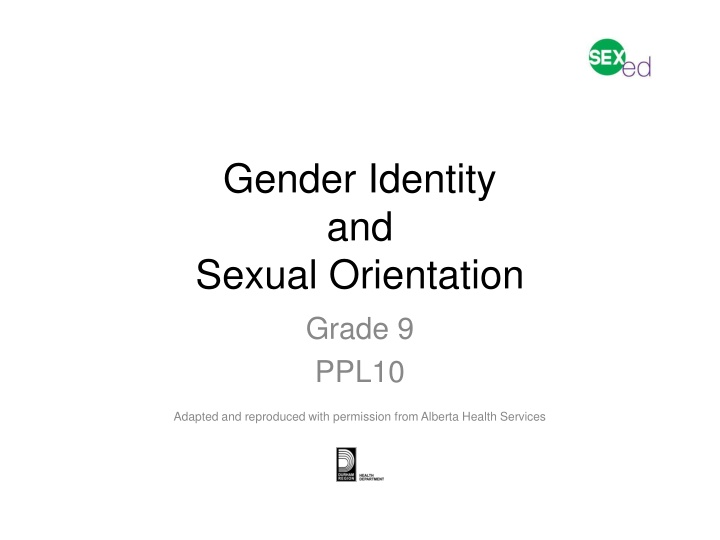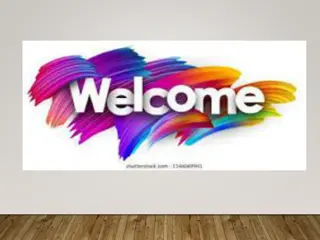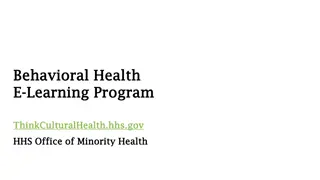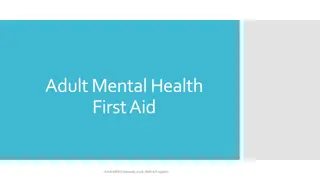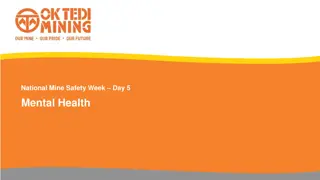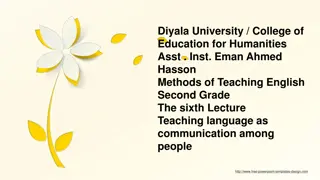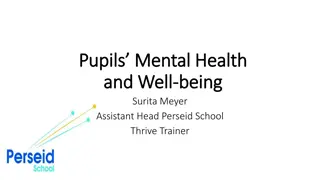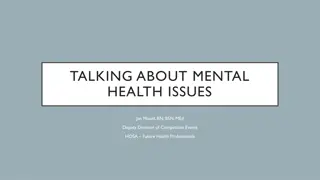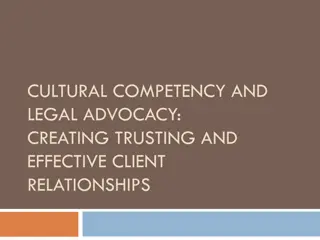BMER Communities and Cultural Competency in Mental Health Services
The Islington Community Wellbeing Development Service conducted a Quarterly Community Conversation in December 2015, focusing on Black, Minority Ethnic, and Refugee (BMER) communities' needs in mental health services. The event included discussions, presentations, and recommendations to address important issues such as participation, co-production, equality, diversity, and training in mental health services catering to diverse communities.
Download Presentation

Please find below an Image/Link to download the presentation.
The content on the website is provided AS IS for your information and personal use only. It may not be sold, licensed, or shared on other websites without obtaining consent from the author.If you encounter any issues during the download, it is possible that the publisher has removed the file from their server.
You are allowed to download the files provided on this website for personal or commercial use, subject to the condition that they are used lawfully. All files are the property of their respective owners.
The content on the website is provided AS IS for your information and personal use only. It may not be sold, licensed, or shared on other websites without obtaining consent from the author.
E N D
Presentation Transcript
Gender Identity and Sexual Orientation Grade 9 PPL10 Adapted and reproduced with permission from Alberta Health Services
Diversity and inclusion DIVERSITY: o Differences among people are accepted and celebrated rather than viewed as sources of separation INCLUSION: o Everyone, regardless of race, culture, religion, gender, language, disability, sexual orientation, or any other attribute is included as part of the whole 2
CANADIAN HUMAN RIGHTS ACT (1985) All individuals have an equal opportunity to make for themselves the lives that they are able and wish to have, without being hindered or prevented by discriminatory practices based on: o Race o National or ethnic origin o Colour o Religion o Age o Sex o Sexual orientation o Marital status o Family status o Disability o A conviction that has been pardoned 3
SEXUAL IDENTITY All living things appear in nature with a wide range of naturally occurring variations. Humans vary in skin colour, hair colour, height, etc. Just as we would expect to see people with red hair, blue eyes, or who are left- handed, it is also normal to expect to see a wide range of diversity within the spectrum of human sexual identity 4
SEXUAL IDENTITY Sexual identity is developed from any number of influences before, during, and after birth Four distinct and fluid characteristics shape how we think about ourselves and how we relate to others as sexual beings: o Biological Sex o Gender Identity o Sexual Orientation o Gender Expression 5
Biological Sex Classification based on our anatomy or genetics MALE INTERSEX FEMALE (XY) (XX) Biological sex is not always obvious Some people are born with physical characteristics of both sexes (intersex) Intersex conditions are not always visible at birth, and may not be noticed until puberty (when hormones produce unexpected changes) or during medical procedures 6
Gender Identity One s internal and psychological sense of oneself as male or female, or both or neither, regardless of sexual orientation There are some people who question their gender identity and may feel unsure of their gender Some people feel they are not of the same gender as their biological sex or physical body 7
Gender Identity: Cisgender The term cisgender refers to people whose sex and gender are congruent by predominant cultural standards: women who have female bodies, men who have male bodies 8
Gender Identity: Transgender The term transgender is used to refer to a person whose biological sex (i.e., anatomy, hormones, chromosomes) is inconsistent with their gender (i.e., sense of self, behavior, appearance). Some transgender people seek to change their sex to match their gender using medical procedures (i.e hormones, surgery). 9
GENDER IDENTITY IS NOT THE SAME AS SEXUAL ORIENTATION: Sexual orientation is determined by a pattern of romantic, sexual, and emotional attractions felt by an individual toward members of the same sex, the opposite sex, or all sexes. o Who do you love? o Who are you attracted to? o Who do you care for? 10
Sexual Orientation Heterosexual: attracted to individuals of the opposite sex (straight) Homosexual: attracted to individuals of the same sex (gay, lesbian) Bisexual: attracted to both sexes Queer: attracted to the same or both sexes and/or transgendered individuals Asexual: not experiencing sexual attractions 11
Gender Expression The roles that men and women adopt A collection of attitudes and behaviours that are considered normal and appropriate in a specific culture for a particular sex It can also be defined as how we communicate our gender to others Masculine Feminine 12
Activity: Aspects of Identity 14
Activity: Aspects of Identity These are the aspects of identity of a Grade 9 student. 1. Which aspects can t be chosen (e.g. born with)? And which are things you can chose? Does the student have the power to change certain aspects or not? 2. Have you made any assumptions about the gender or sexual identity of this student? 3. How do you think this student would feel about wanting to ask someone out on a date? 15
Activity: Aspects of Identity Now open the small envelope included with your student s aspects of identity. 1. How does his/her gender and sexual orientation or gender identity affect your previous assumptions about this student? Do you see your student differently now? 2. Out of all these aspects of identity, which would be hidden or unknown to people unless they were told about them? 3. How do you think this student would feel in the change room after gym class? 16
TYPES OF DISCRIMINATION: HOMOPHOBIA Making generalizations (stereotyping) and/or treating a person or a group unfairly (discrimination) who are thought of as gay/lesbian or bisexual. An irrational fear, hatred or repulsion of this group. Often exhibited by prejudice, discrimination, intimidation, or acts of violence. 17
TYPES OF DISCRIMINATION: HETEROSEXISM The belief or assumption that everyone is heterosexual and that heterosexuality is the only right and natural sexual orientation The belief that heterosexuality is superior to homosexuality Heterosexism is often expressed in more subtle forms than homophobia 18
Community Resources LGBTQ PRIDELINE Durham PFLAG Durham Region PRIDE Durham Sexual Health Clinics 19
LGBTQ PRIDELINE Durham This helpline provides emotional support, crisis intervention, and community referral information specific to the concerns and issues of the LGBTQ community in Durham Region. 20
Who Calls? Questioning or confused about their sexual identity or orientation Experiencing troubling or suicidal thoughts who may be identified as LGBTQ Experiencing bullying or isolation and feel that this may be a reaction to their sexual identity or orientation At risk of homelessness or other dangerous situations due to disclosing their sexual orientation (may be asked to leave the home) Are experiencing problems at work due to their LGBTQ status Are being "Gay Bashed" Are a parent or sibling of someone who is LGBTQ identified and you have questions or simply need to talk about how you are feeling Are looking for referrals to LGBTQ "friendly" services 21
PFLAG Canada Durham Region, ON PFLAG Durham Region provides support, education and resources on issues of sexual orientation and gender identity/expressions for gay, lesbian, bisexual, transgender, transsexual, two-spirit, intersex, queer, and questioning persons and their families and friends. Peer-to-peer support teams are available by phone or email to talk about anything you want to discuss about your own sexuality/gender expressions or the gender/sexuality of members of your family or friends. 905-231-0533 Email: support@pflagdurhamregion.com pflagdurhamregion.com 22
Pride DURHAM Pride Durham is a not-for-profit organization that hosts Pride and social events in Durham Region including the annual region-wide Pride the second weekend in June, celebrating Lesbian, Gay, Bi- sexual, Transgendered and Queer (LGBTQ) and associated peoples throughout our community. Pride Durham exists to celebrate our culture, commemorate our heritage, educate against homophobia, and empower our diverse lesbian, gay, bi-sexual, transgendered, and associated community across Durham Region. PrideDurham.com 23
Sexual Health Clinics 3 clinics in Durham Region: Oshawa, Pickering and Port Perry Provide sexual health information, education, counseling, testing, treatment, birth control and referrals in a supportive and confidential environment durham.ca/sexualhealth 24
